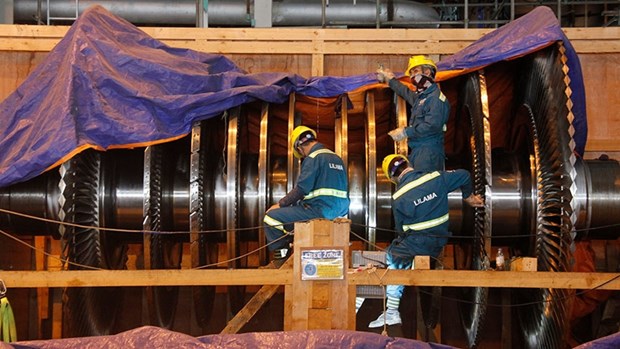Imprints on national power generation map
After nearly seven years of construction with unprecedented difficulties, the Song Hau 1 thermal power plant has been put into commercial operation, contributing to ensuring national energy security and economic development in the Mekong Delta.
 Workers install a turbine of the Song Hau 1 thermal power plant. (Source: petrovietnam.petrotimes.vn)
Workers install a turbine of the Song Hau 1 thermal power plant. (Source: petrovietnam.petrotimes.vn)Overcoming difficulties
Inaugurated officially on July 16 on the occasion of the 60th anniversary of the Traditional Day of Vietnam National Oil and Gas Group (PetroVietnam), the Song Hau 1 thermal power plant has a capacity of 1,200MW.
Few people know that the project was sometimes behind schedule. Construction of several important areas were delayed for years due to unprecedented difficulties.
It is one of the first power projects to apply an adjusted contract price mechanism under the Prime Minister’s Decision No.2414/QD-TTg, and stakeholders were confused about payment and unit prices, thus greatly affecting the plant’s progress.
Second, the bidding for the supply of a fuel desulfurisation system was 34 months late.
The COVID-19 pandemic during 2020-2021 also seriously impacted the progress in the final stage.
Put into commercial operation on April 12, the plant is now officially part of the national power generation map.
Triumph over COVID-19
During a serious outbreak of COVID-19 in 2021, the project’s management board and general contractor LILAMA launched a number of strict pandemic prevention and control measures, such as arranging the “three on spot” option or “one route, two destinations” to mitigate the risk of infection. During peak periods, workers followed the “three on spot” rule, including living and working together for six consecutive months.
The management board, LILAMA, and sub-contractors adjusted plans to ensure all work was completed and mitigated against the risk of pandemic infection, including adjusting the timeframes for several works, and using domestic sources to perform the tasks of foreign experts.
Though progress was affected, the construction site was still busy.
It was very tough period but workers on the site overcame it successfully.
Achievements from emulation campaigns
With the support of PetroVietnam, its trade union, the project’s management board and its trade union effectively spread emulation campaigns to improve labour productivity, creativity and cost saving.
They encouraged workers to go about their business in a professional, friendly and competitive manner, which has been hailed by PetroVietnam leaders.
Each campaign received a warm response from thousands of workers on the construction site, creating a driving force for them to overcome difficulties and fulfill their targets.
Outstanding growth of PetroVietnam
The success of the Song Hau 1 thermal power plant is evidence of PetroVietnam’s outstanding growth in its role as an investor in national key energy projects.
Since the groundbreaking ceremony in 2015, PetroVietnam’s leaders have inspected the construction site many times to grasp the situation and offer timely directions.
During urgent times, they even established working groups to directly tackle difficulties.
Their support became a great source of encouragement to officers on the management board and workers on the construction site, helping them stand united during difficult challenges.
PetroVietnam has so far put into safe and stable operation two coal-fired power plants with a total capacity of 2,400MW, four gas thermal power plants with a combined capacity of 2,700MW, and two hydropower plants with 305MW. The total installed capacity of PetroVietnam’s power plants amounts to 5,405MW, accounting for over 7% of the total and about 10% of the national power output. These figures affirm PetroVietnam’s role and position as the second biggest power generator in the country.
With its ability and experience, PetroVietnam has pledged to run the Song Hau 1 thermal power plant safely, stably and effectively. It will work more closely with Electricity of Vietnam to optimise its power output, thus meeting demand in the southwest and the national power grid./.












